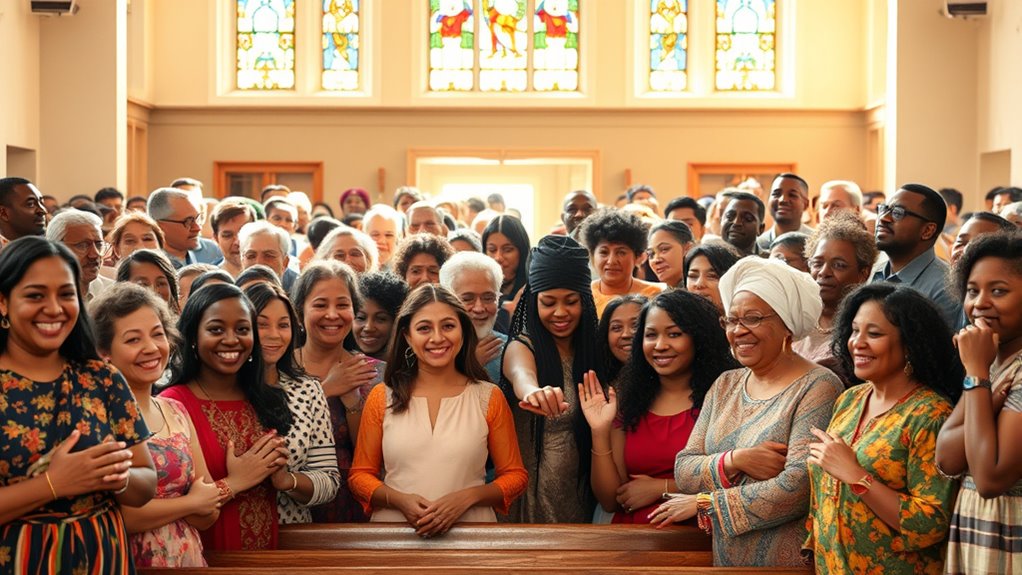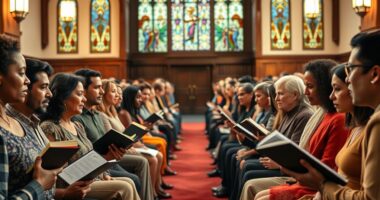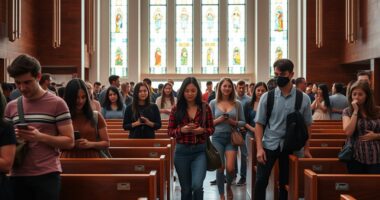Embracing diversity in your congregation involves recognizing different cultural backgrounds, celebrating heritage through festivals, music, and food, and creating an inclusive environment where everyone feels welcome. You can do this by planning multicultural worship, encouraging open dialogue, and involving members in cultural activities. Address biases, foster understanding, and build bridges through shared experiences. If you choose to explore more, you’ll discover practical ways to strengthen your community and truly celebrate its diversity.
Key Takeaways
- Foster inclusive worship by incorporating multicultural music, languages, and rituals to make all members feel valued.
- Promote interfaith and intercultural dialogue through safe spaces, shared activities, and respectful conversations.
- Celebrate cultural diversity with heritage festivals, storytelling, and themed events that deepen understanding and connections.
- Develop cultural competence via training, active listening, and addressing unconscious biases to create a welcoming environment.
- Engage in community partnerships and collaborative projects to build relationships and demonstrate commitment to diversity.
Understanding the Importance of Diversity in Faith Communities
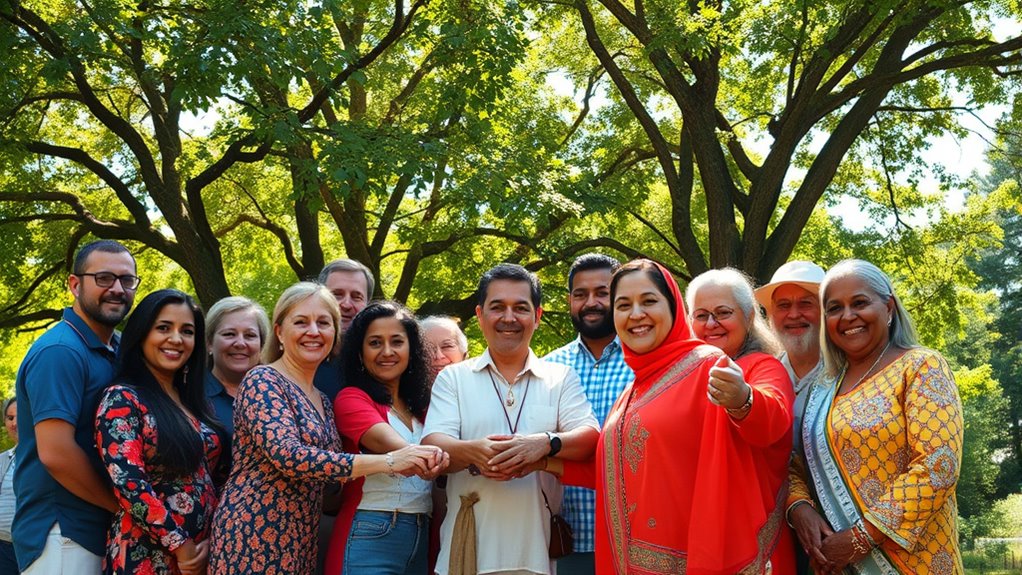
Have you ever wondered why diversity matters in faith communities? Embracing different backgrounds enriches your congregation and fosters understanding. Interfaith dialogue opens doors for meaningful conversations between diverse faiths, breaking down stereotypes and building respect. Multicultural outreach invites everyone to participate, making your community more inclusive and vibrant. When you welcome varied perspectives, you create a space where people feel valued and understood. This diversity strengthens your congregation’s resilience, encourages empathy, and broadens spiritual growth. Recognizing the importance of diversity isn’t just about representation—it’s about actively engaging with different cultures and beliefs. By prioritizing interfaith dialogue and multicultural outreach, you help cultivate a faith community that reflects compassion, unity, and genuine acceptance.
Recognizing Cultural Differences and Celebrating Heritage
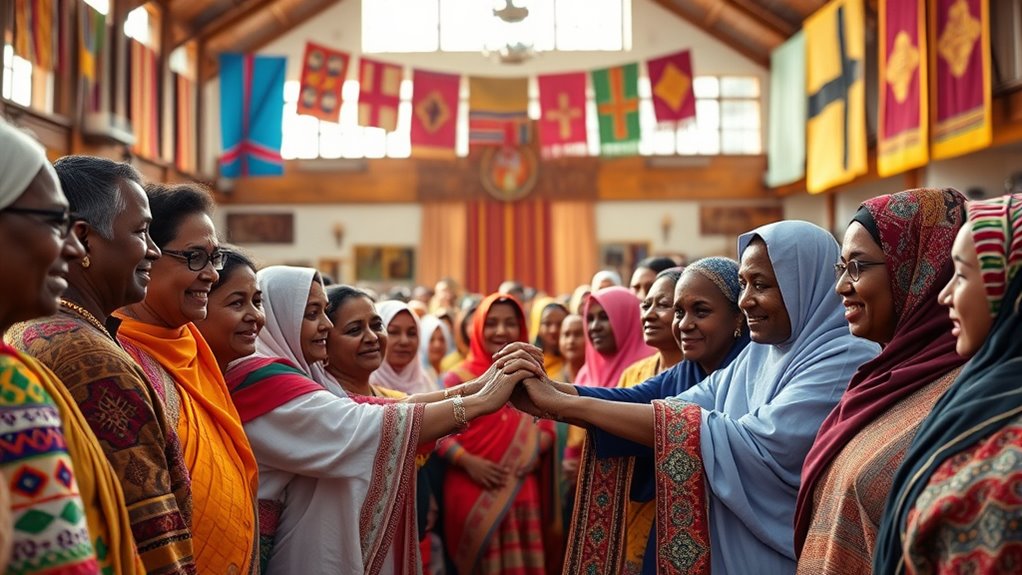
Recognizing cultural differences and celebrating heritage deepen the bonds within your congregation by honoring the unique identities each member brings. Engaging in cultural storytelling helps members share their backgrounds and traditions, fostering understanding. Heritage celebrations, whether through festivals, music, or food, create tangible connections and show appreciation for diverse histories. You can encourage members to participate in sharing their stories or leading cultural activities, making everyone feel valued. Remember, small gestures like cultural displays or themed events can make a significant impact. By actively acknowledging and honoring these differences, you create a welcoming environment where every person feels seen and respected. Incorporating lifestyle practices that promote inclusivity can further strengthen community ties. Embracing this diversity strengthens your congregation’s unity and enriches your collective faith journey.
Creating Inclusive Worship Services and Events

Creating inclusive worship services and events requires intentional planning to guarantee everyone feels welcome and engaged. To achieve this, consider fostering interfaith collaboration, which brings diverse perspectives and practices into your services, enriching the experience for all. Incorporate multicultural outreach by including music, rituals, and language from different cultures, signaling that multiple traditions are valued. Make certain accessibility by providing materials in various languages and accommodating different physical needs. Use diverse leadership and volunteers to reflect your congregation’s makeup, promoting a sense of belonging. Be mindful of seating arrangements, visuals, and signage that celebrate diversity. Additionally, understanding the impact of color accuracy can help in designing visually welcoming environments that resonate with everyone. By intentionally designing these aspects, you create a welcoming environment where every individual feels seen, heard, and spiritually nurtured.
Building Bridges Through Open Dialogue and Education
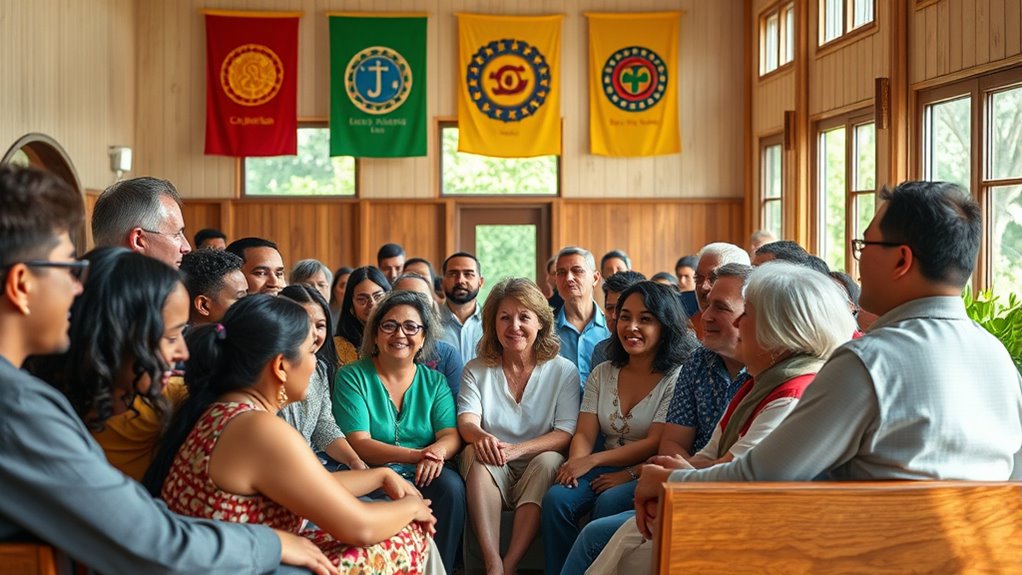
You can strengthen your congregation by encouraging honest conversations that break down barriers. By promoting cultural awareness, you open doors for understanding and respect among members. When everyone actively participates in these dialogues, your community becomes more inclusive and connected. Incorporating best practices from diverse cultural backgrounds can further enhance mutual appreciation and unity.
Fostering Honest Conversations
How can honest conversations bridge divides within your congregation? By creating a safe space for open dialogue, you encourage members to share their perspectives and listen actively. This approach fosters understanding and respect, essential for embracing diversity. Incorporate interfaith dialogue to explore different beliefs, breaking down misconceptions. Use multicultural art as a visual tool that sparks conversations and celebrates various cultures. Establish ground rules for respectful communication to ensure everyone feels heard. Host discussion forums focused on shared values, encouraging genuine exchanges. When members feel safe to express themselves honestly, barriers diminish, and unity grows. Building bridges through transparent conversations not only deepens connections but also strengthens the foundation of an inclusive, diverse congregation. Recognizing informal language can help facilitators connect with different age groups and backgrounds, making dialogue more relatable and effective.
Cultivating Cultural Awareness
Building on the foundation of honest conversations, cultivating cultural awareness involves actively seeking to understand and appreciate the diverse backgrounds within your congregation. You can facilitate this by organizing interfaith dialogues, which promote mutual respect and deepen understanding across different faith traditions. Additionally, engaging in multicultural outreach helps break down barriers and highlights common values. Encourage your members to participate in educational events, cultural celebrations, and shared learning experiences. These activities foster empathy and challenge stereotypes, creating a more inclusive environment. By intentionally creating opportunities for open dialogue and learning, you help your congregation develop a genuine appreciation for diversity. This ongoing effort builds trust, strengthens relationships, and embodies the spirit of unity in your faith community. Incorporating artistic expression into your programs can also serve as a powerful tool for fostering understanding and connection among diverse groups.
Encouraging Active Participation
Encouraging active participation in your congregation requires creating spaces where open dialogue and education are prioritized. By fostering an environment that welcomes spiritual diversity and promotes interfaith dialogue, you invite members to share their perspectives confidently. You can do this by organizing discussion panels, workshops, or forums that highlight different faith traditions and beliefs.
- Facilitate conversations that challenge assumptions and deepen understanding
- Offer educational sessions on various spiritual practices and worldviews
- Encourage members to lead discussions, sharing their personal experiences
- Incorporate diverse designs and materials into community projects to symbolize inclusivity and creativity
These efforts help break down barriers, build trust, and inspire ongoing engagement. When people feel heard and valued, they’re more likely to participate actively, enriching the community’s collective growth and unity.
Addressing Challenges and Overcoming Barriers to Inclusion

To foster genuine inclusion, you need to recognize your unconscious biases and understand how they influence your interactions. Building cultural competence helps you connect more authentically with diverse members of your congregation. By facilitating open dialogue, you create a space where challenges can be addressed openly and barriers can be broken down effectively. Being aware of diverse programming options can further support your efforts to create an inclusive environment.
Recognizing Unconscious Bias
Have you ever wondered how unconscious biases influence the way your congregation perceives and interacts with others? Recognizing these biases is vital to fostering inclusion. Implicit stereotypes often operate beneath your awareness, shaping judgments without you realizing it. Developing bias awareness helps you identify these hidden influences and challenge them. Becoming aware of narcissistic traits can also help you identify and understand behaviors that may hinder genuine connection and empathy within your community.
To do this, consider:
- Reflecting on your automatic reactions and assumptions
- Listening openly to others’ experiences and perspectives
- Engaging in training exercises that reveal implicit stereotypes
Building Cultural Competence
Building cultural competence is essential for overcoming challenges and breaking down barriers to inclusion within your congregation. By engaging in interfaith dialogue, you foster understanding and respect among diverse faith traditions, reducing misconceptions and prejudices. Multicultural outreach efforts help your congregation connect with different communities, demonstrating genuine acceptance and openness. To build this competence, you must actively listen to others’ experiences, educate yourself about different cultures, and challenge your assumptions. Creating opportunities for meaningful interactions encourages members to appreciate diversity and develop empathy. Recognizing and addressing cultural differences helps remove obstacles to participation and belonging. As you prioritize cultural competence, your congregation becomes a more welcoming space where everyone feels valued, understood, and inspired to contribute to a shared spiritual journey.
Facilitating Open Dialogue
Fostering open dialogue is a vital step in overcoming challenges and removing barriers to inclusion within your congregation. When you encourage honest conversations, you create a safe space for members to share their perspectives and experiences. Addressing issues like language barriers is essential—use translation services or multilingual resources to guarantee everyone feels heard. Promoting interfaith dialogue helps break down misconceptions and fosters mutual respect. Be mindful of cultural sensitivities and listen actively to prevent misunderstandings. Recognizing and respecting Dog Names can also serve as a way to build rapport and community spirit among members.
- Encourage small group discussions to deepen understanding
- Provide language support to include non-native speakers
- Organize interfaith events to promote shared learning and respect
Engaging Youth and New Members From Diverse Backgrounds
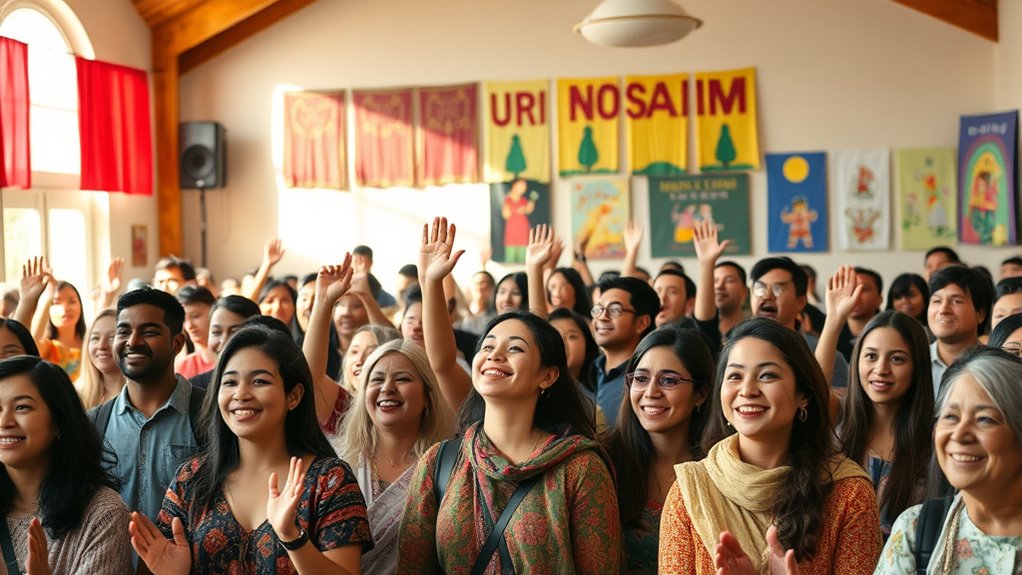
How can your congregation effectively engage youth and new members from diverse backgrounds? Start by creating spaces that encourage interfaith dialogue, allowing young people to share their beliefs and experiences openly. Incorporate multicultural outreach activities that celebrate different traditions, making everyone feel seen and valued. Offer programs tailored to diverse interests, such as cultural festivals, language classes, or discussion groups focused on social issues. Use social media and digital platforms to reach younger audiences where they are active. Foster an inclusive environment by training leaders to be culturally sensitive and approachable. Additionally, leveraging virtual hackathons can promote collaboration and innovation among youth from various backgrounds. By embracing these strategies, you foster genuine connection, build trust, and create a welcoming atmosphere that invites youth and new members to participate fully in your congregation’s life.
Leveraging Community Resources to Foster Connection
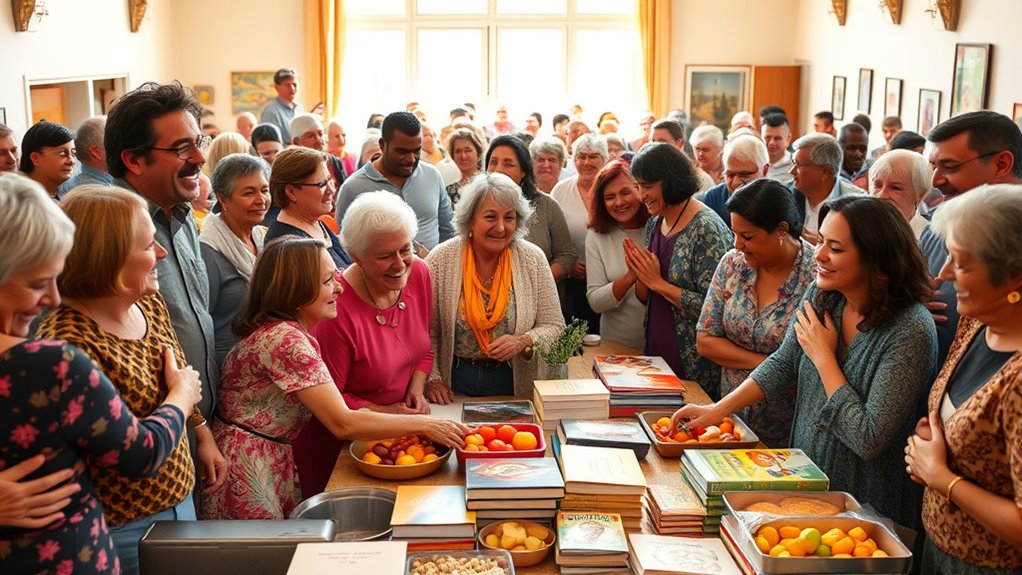
Engaging youth and new members from diverse backgrounds often requires expanding your reach beyond your congregation’s walls. You can leverage community resources to build meaningful connections that foster inclusion. Start by establishing interfaith collaborations, which create opportunities for shared events and mutual understanding. These partnerships demonstrate your commitment to diversity and open dialogue. Additionally, enhance your community outreach by partnering with local organizations that serve underrepresented groups, offering support and resources.
- Organize joint service projects that bring different communities together
- Promote cultural events that celebrate diversity and encourage participation
- Create dialogue forums to facilitate open conversations about inclusion
Using these strategies, you strengthen your community fabric and demonstrate your congregation’s dedication to embracing all backgrounds through active collaboration.
Measuring Progress and Sustaining a Culture of Acceptance

Tracking your progress is crucial to ensuring that your efforts to create an inclusive congregation are effective and lasting. To measure success, set clear, achievable goals and regularly assess how well your initiatives are fostering acceptance. Use surveys, feedback sessions, and participation rates to gauge engagement levels and identify areas for improvement. Sustaining engagement requires ongoing communication, celebrating milestones, and adapting strategies to meet the evolving needs of your community. Keep track of diverse voices and ensure everyone feels heard and valued. By continuously monitoring these indicators, you can reinforce a culture of acceptance that persists over time. Remember, measuring progress isn’t a one-time task—it’s a indispensable part of maintaining momentum and deepening your congregation’s commitment to diversity.
Frequently Asked Questions
How Can I Personally Challenge My Biases Within the Congregation?
You can challenge your biases by engaging in personal reflection regularly, honestly examining your thoughts and feelings. Practice bias recognition by identifying stereotypes or prejudiced attitudes when they arise. Actively seek out diverse perspectives within your congregation, listen openly, and question your assumptions. By consistently questioning and reflecting, you’ll become more aware of your biases and foster a more inclusive, welcoming environment for everyone.
What Are Effective Ways to Handle Cultural Misunderstandings?
Think of cultural misunderstandings as bridges waiting to be built. You can handle them by fostering interfaith dialogue, encouraging open conversations where everyone feels heard. Celebrate cultural festivals together to turn differences into shared joy. When misunderstandings arise, listen actively, ask respectful questions, and seek common ground. This approach transforms potential conflicts into opportunities for growth, helping your congregation become a vibrant tapestry woven with understanding and mutual respect.
How Do I Involve Diverse Voices in Decision-Making Processes?
You involve diverse voices by actively engaging community outreach efforts and fostering leadership development among different cultural groups. Create inclusive forums where everyone feels safe to share their perspectives, and encourage participation in decision-making processes. By intentionally reaching out and empowering leaders from varied backgrounds, you guarantee a richer, more representative congregation, strengthening unity and understanding. Your proactive approach makes diversity a core strength of your community.
What Resources Can Support Ongoing Diversity Training?
You can find resources supporting ongoing diversity training through online platforms like the Pew Research Center or the National Diversity Council, which offer workshops on cultural competency and inclusive leadership. Consider subscribing to leadership development programs that focus on these areas. Engaging with local organizations or hiring consultants specializing in diversity can also provide tailored training sessions, helping you foster a more inclusive environment and strengthen your congregation’s commitment to diversity.
How Can We Sustain Enthusiasm for Diversity Initiatives Long-Term?
You can sustain enthusiasm for diversity initiatives long-term by regularly engaging your congregation through faith-based outreach and community engagement activities. Keep momentum by celebrating milestones, sharing stories of impact, and involving members in planning. Encourage open dialogue, provide ongoing education, and create opportunities for diverse voices to be heard. This continuous involvement fosters a sense of shared purpose, making diversity efforts meaningful and enduring within your congregation.
Conclusion
Just as the Tower of Babel aimed for unity yet faced confusion, embracing diversity in your congregation builds a stronger, more vibrant community. By actively welcoming all backgrounds, you echo the spirit of Pentecost—where every voice matters. Keep fostering open dialogue, celebrating heritage, and overcoming barriers. As you nurture this inclusive environment, you create a place where everyone feels seen and valued, fulfilling the divine call to love thy neighbor in all their beautiful differences.

